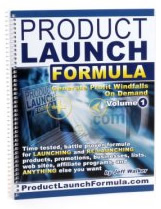
Jeff Walker is going to tell us about the Product Launch Formula that is used to launch and re-launch products online. Jeff’s a guy that can consistently get $1000 ECPM from his lists and now he’ll tell you how he does it. 🙂
I’m quite familiar with Jeff’s Product Launch Formula. I know it works. I’ve seen it work. Its about time we ran this interview with Jeff because this is good stuff. Apple and other companies use similar methods when they launch new products (another MeetInnovators list member guided Apple through this process using Jeff’s methods).
Full Interview Audio and Transcript
Personal Info
Hobbies and Interests: Mountain biking, skiing, playing guitar, white water rafting, hiking, and spending time with his kids.
Favourite Sports Teams: Denver Broncos, Colorado Rockies, Colorado Avalanche.
Favourite Books:
- Influence: The Psychology of Persuasion by Robert B. Cialdini
- The Alchemist by Paulo Coelho
Favourite Entrepreneurs: Dan Kennedy, John Reese, Frank Kern, Yanik Silver, Tony Robbins.
Company Website: http://productlaunchformula.com/
Fast Track Interview
Adrian Bye: I’m talking with Jeff Walker from Product Launch Formula. I’ve known Jeff since 2003 or 2004. He is the brains behind something that’s been very successful in the information marketing community called a product launch, and he is here to talk about it. Jeff, why don’t you tell us a little bit about who you are and what you do?
Jeff Walker: In 1996, I had a passion for the stock market and started selling primarily stock market information online to day traders and investors. I had a business degree from Michigan State University but no real knowledge of marketing. I didn’t have selling or real marketing experience. I had never even run a business.
It turned out I had some decent content and was really good at selling online. I gradually started to figure a few things out about selling. I bootstrapped everything, built the business out of my basement, and then stumbled onto something I call the Product Launch Formula.
With this formula I would release new products or re-release current products. My first product launch was $1,400. Then I did one that was $28,000. I began to see sale results where in a week I would make the amount of sales that typically took me a year. It was true profit because I built up a list and literally the only expense I had was merchant fees because it was an information product with digital delivery and no marketing cost.
 In 2003, I started talking publicly about this formula of releasing products gradually. Then I started taking on clients in addition to teaching others in the information marketing space. Suddenly, I did $106,000, which back then six figures in seven days seemed like a big deal. Now multiple times we’re seeing $1 million in an hour. Recently when I released a product, we did $1 million in an hour, and over a day period we did almost $4 million. People have used this formula with nearly any type of product, service, niche or market you could imagine.
In 2003, I started talking publicly about this formula of releasing products gradually. Then I started taking on clients in addition to teaching others in the information marketing space. Suddenly, I did $106,000, which back then six figures in seven days seemed like a big deal. Now multiple times we’re seeing $1 million in an hour. Recently when I released a product, we did $1 million in an hour, and over a day period we did almost $4 million. People have used this formula with nearly any type of product, service, niche or market you could imagine.
Adrian Bye: Why don’t you talk about some of the list sizes you’re working with and the sorts of results you’re seeing?
Jeff Walker: If I’m doing an internal launch, which is just a launch to my house list, I’m looking for a minimum of $50 in revenue per e-mail address on the list; I have even achieved close to $150 in some launches. This is with small lists of 10,000, 50,000, and 100,000.
The one with almost $4 million was a list of about 45,000, but it was a full out external launch where we used our house list and also went to joint venture partners who were mailing. It’s impossible to calculate exactly on a per name basis because we don’t know how many of our partners are mailing and the metrics get a little messy.
I’ve done some launches with lists of 1,000 or 2,000, but typically we’re working with a list of anywhere from 10,000 to 100,000 to get those kinds of metrics.
Adrian Bye: What happens from the start to the finish of a launch?
Jeff Walker: The key is we’re always looking to turn our marketing into an event, and we’re always looking to create conversations with our prospect. It’s a sequence deal. From the very beginning, you’re letting your market know something is coming. This is pure direct marketing.
If we look at direct mail, there’s often been a three-letter sequence where you send a letter and you follow up with another letter to whoever hasn’t bought asking, “Why haven’t you bought?” Then there’s another letter saying, “Just frankly, I’m puzzled. I noticed you still haven’t taken advantage of this.” The problem with this is it costs money, there’s no interaction, and it’s slow.
With the Internet, the speed of communication is obviously faster than we’ve ever had with any other type of publishing media. The cost of that communication is negligible, and there is the interactive component.
If you put together a sequence that is e-mail-driven, blog-driven, Twitter-driven and you’re asking for feedback in the first piece of the sequence, you’ve now opened up the conversation. Basically you’re trying to get people excited and let them know something’s coming.
When people hit a sales page or get into a sales process, their defensive mechanisms and detectors immediately go on full-out red alert. The way we’re doing it is gradually working them into the process by starting with a survey and coming back with some good content around the offer while educating them. We’re gradually taking them into the sales process without turning on all their defensive mechanisms.
Often the way I’ll do it is with a survey or a simple e-mail asking for a response. This happens often three or four weeks in advance of the launch. We’ll do the initial survey or just ask them for feedback and send them to a blogpost where we’re asking, “We’ve got this product. We’re just about to release it. We just want to make sure we have everything covered. Could you tell us what’s the most important feature or the most important thing you want to know?” It doesn’t matter whether it’s an information product, a service or a hard good, we are looking for feedback to get that interaction going.
 When they give you the feedback, they’re giving you questions that are really objections. Now your goal is to answer those objections in the pre-launch process. That’s typically done by publishing some special reports, some videos, some audios, blogposts, or PDFs within a few days. A week later you come back with more content. The content is usually educational as well as aspirational and speaks to the underlying want that you’re looking to fulfil. You’re also answering whatever objections they have raised. The whole idea is to get them more excited, and to make them feel engaged in the conversation.
When they give you the feedback, they’re giving you questions that are really objections. Now your goal is to answer those objections in the pre-launch process. That’s typically done by publishing some special reports, some videos, some audios, blogposts, or PDFs within a few days. A week later you come back with more content. The content is usually educational as well as aspirational and speaks to the underlying want that you’re looking to fulfil. You’re also answering whatever objections they have raised. The whole idea is to get them more excited, and to make them feel engaged in the conversation.
Within the sequence you are using a lot of the standard influence triggers. These are the mental triggers that have worked and will continue to work. Some of them are scarcity, social proof, commitment, consistency, and community. There are probably about 10 of them that we hit, and you don’t have to always hit all of them.
Overall we’re taking them through a three or four-week period where we’re gradually doing a soft sell over time, and getting them more excited. Then typically, we will walk down to launch day and we’ll have some type of a special offer, special pricing, special bonuses, or limited quantity. It’s something that gets them to act right on launch day. Then it’s simply a matter of hit and send, and at launch day the sales come pouring in. Then there’s a whole follow-up process after that launch day.
You can do a launch that’s a day, a week, two weeks long or whatever, but what you end up with is this huge flow of sales coming in. If you do this properly, you also build incredible rapport through the process and end up with extremely happy buyers, which means you end up selling to them again and again and again. Even the prospects that don’t buy tend to be very enthusiastic and happy.
Adrian Bye: Maybe you can talk about the Neil Strauss launch. He’s the author of The Game which has been on the New York Times Bestselling List for a long time.
Jeff Walker: Basically, Neil has an information product on how to meet and pick up women. I didn’t personally work on this launch, but I bounced a few ideas around with Frank Kern, who ran the launch. Neil provides videos at a very high price point. They also had a nice scarcity element because they only had so many available. Since they had a hard limit on the number of copies they would sell, which I think was around $1.5 million, they completely sold out within a few hours. That product was not about how to make money at all; it was just about how to pick up women. He walked right through the whole product launch method, and it was successful.
My clients have had great success in all kinds of weird little niches. John Gallagher sold an educational board game about edible and medicinal plants and herbs. There have been products for carving wooden dolls, massage therapy, and business coaching in Poland. This stuff’s been done all over the world: Europe, South America, Asia, and the Middle East.
Adrian Bye: The business coaching in Poland worked?
Jeff Walker: This stuff can be so cookie cutter, you can literally drop it into various markets. In my course, I gave a sales letter I had used in a product about day trading. The lady in Poland took that sales letter, pretty much cut-and-pasted it and used it for her business coaching. Obviously, she had to change the offer and the product, but the whole sales letter was essentially my stock trading sales letter. It worked great with business coaching in Poland.
It works in all kinds of markets and niches with online and offline services. Right now, everyone has too much media coming at them. If we look at 10 or 15 years ago, we didn’t have cell phones, e-mail, instant messaging, text messaging, 500 channels on TV, satellite radio and advertising on your airplane tray when you fold it down. A year and a half ago, we didn’t have Twitter.
We have so much more media coming at us, but our brains have not expanded their capacity to absorb all of that. There’s this incredible marketing fog and people are not reading or even seeing your messages. At the same time, people are fundamentally bored and disconnected.
In my opinion, people don’t spend much time interacting with other people. They don’t spend as much time building relationships with other people because they’re sitting in front of their computer answering e-mails. They’re sitting with their BlackBerry until all hours of the night. You have this combination of a fog of too much media coming at us and, at the same time, we’re fundamentally bored and looking for a connection.
If you put together one of these launches, you end up cutting through the fog by creating a connection. You create a relationship with thousands of people through this process by collectively walking through a process that leads up to an event with communal feel. It’s where just going through something together with a large group of people at the same time creates excitement.
Adrian Bye: What do you say to people who say it’s a scam?
 Jeff Walker: There’re plenty of people that think it’s a bunch of charlatans. All I know is that my clients and students have done well over $100 million in launches in the last couple of years. It’s worked for all kinds of things. It’s basic human influence. Every one of us is trying to influence people as we go through the day. This is just a technique to amplify that influence.
Jeff Walker: There’re plenty of people that think it’s a bunch of charlatans. All I know is that my clients and students have done well over $100 million in launches in the last couple of years. It’s worked for all kinds of things. It’s basic human influence. Every one of us is trying to influence people as we go through the day. This is just a technique to amplify that influence.
If I said, “On pain of death, you have to go sell this person this product and you have 24 hours to do it,” you would probably drive over to their house, sit in front of them and try to make the sale that way. If you have to make a sale, generally the best way to do it is in a face-to-face environment because then you can read all the cues coming off of someone.
You can see if they’re interested, if their eyes are rolling or whatever. It’s more effective to sell face-to-face than say via magazine advertisement, direct mail or even telemarketing. That one-to-one sale is the most effective way, yet the only problem is that it doesn’t scale. You can’t make tons of sales sitting in front of someone.
With Product Launch Formula, we’ve taken the best of both worlds. You get the scale by publishing but with the interaction that you build with the entire market. Even if it’s not one-on-one interaction, you get a lot of the benefits that you would get from that face-to-face selling. Now the market starts to guide what triggers you need to hit, what you need to say next, and how they want to be sold.
Adrian Bye: What are some of the biggest launches that have happened in the Internet marketing world?
Jeff Walker: There’re two answers to that one. StomperNet did a launch where they put about 1,500 or 1,600 people into a program that cost $800 a month. They built a business that was doing over $1 million a month. In the last couple of years since then, I think their business has done at least $30 million in sales. I think that’s probably the biggest launch, not in terms of launch-day sales but in long-term sales.
When I rolled out my Product Launch Formula course, I did $3.73 million in about 34 hours. After that, Frank Kern’s Mass Control did about $3.5 million, and Rich Schefren had a launch that did about $3.5 million.
A lot of the time people hear these numbers and go into disbelief. They think your product launch is a bunch of hype and you’re going to bankrupt your future by torquing off your market, your niche, your list, your competitors, and your partners.
The reality is the Internet’s a fantastic communication medium, and all you’re doing is using that communication medium to communicate, create relationships and to hopefully form a community. You don’t end up torquing people off. You end up with a really powerful business, a really powerful list, and really happy customers.
This isn’t just a matter of sending a bunch of e-mails. It’s a matter of being interactive, walking people through this process and getting them excited. It’s amazing how creative people have been since I started teaching this stuff. What we’re talking about are mental triggers that work and they’re going to continue to work until basic human psyche changes.
The interaction, the community, the getting people involved, the getting people excited, the positioning, and the market share you can grab for one of these will often go far beyond the dollar sales. I encourage anyone to think about how you can bring what we talked about into your business. You don’t have to do the full out product launch the way I do them. If you only add in 10, 20, or 30 percent of these components in your business, the results can be shocking.









